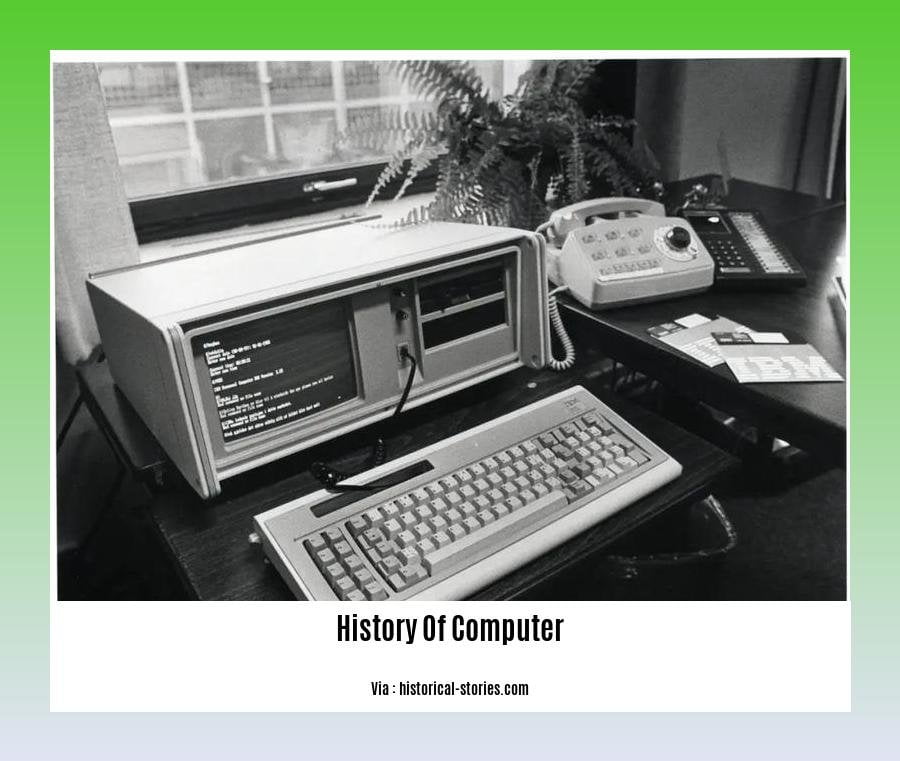[A Journey Through Time: The History of Computers] – Embark on a captivating historical expedition, tracing the revolutionary advancements and profound impact of computers on our world. From the earliest mechanical devices to modern marvels, we explore the generations of computing technology, unlocking the untold stories and transformative moments that have shaped our digital landscape.
Key Takeaways:
- The abacus, created around 2700 B.C., was an early arithmetic device.
- Mechanical calculators, such as Pascal’s machine and Leibniz’s stepped reckoner, were developed in the 17th and 18th centuries.
- Charles Babbage conceptualized the Analytical Engine, the first programmable computer, in the 19th century.
- Alan Turing introduced the concept of a universal computing machine in the 20th century.
- Electronic computers using vacuum tubes, transistors, and integrated circuits were developed in the 1940s and 1950s.
History of Computers: A Journey Through Time

The history of computer is a captivating tale of human ingenuity and technological evolution. From humble mechanical tools to the sophisticated devices we rely on today, computers have revolutionized our lives.
The Early Steps: Abacus and Beyond
The history of computer begins in ancient times with the abacus, a simple counting device invented around 2700 B.C. As civilizations advanced, mechanical calculators emerged in the 17th and 18th centuries, like Pascal’s machine and Leibniz’s stepped reckoner.
The Dawn of Digital Dreams: Babbage and Turing
In the 19th century, Charles Babbage conceived the Analytical Engine, the blueprint for the first programmable computer. While never built, it inspired Alan Turing’s groundbreaking idea of a universal machine.
The Digital Revolution: Vacuum Tubes, Transistors, and Beyond
The 20th century witnessed the dawn of electronic computers. Vacuum tubes, transistors, and integrated circuits paved the way for the development of the first real machines in the 1940s and 1950s.
The Modern Era: Miniaturization and Connectivity
Advancements in miniaturization led to the development of personal computers in the 1970s and 1980s. The invention of the internet in the 1990s connected computers globally, transforming communication, commerce, and entertainment.
The Future of Computers: Artificial Intelligence and Beyond
Today, computers are ubiquitous and continue to evolve rapidly. Artificial intelligence, quantum computing, and cloud-based services are just a glimpse of what the future holds for these indispensable tools.
If you are curious to understand the roots of modern computing, delve into the computer evolution history. Explore the significant milestones that shaped the computing landscape and discover the fascinating journey of computing history over the years. To uncover the evolution of personal computing, embark on a voyage through the annals of history of computing devices and witness the remarkable transformation that has brought us to the present technological age.
Generations of Computers

In the realm of computing, tracing the evolution of machines through the passage of time reveals a captivating narrative of innovation, miniaturization, and growing power. From the colossal vacuum tube behemoths of the first generation to the compact, AI-driven marvels of the present, computers have undergone a remarkable transformation that has reshaped our world.
First Generation (1940-1956): Vacuum Tube Giants
Imagine towering machines consuming entire rooms, generating immense heat and requiring constant maintenance. These were the vacuum tube-based computers of the first generation, the technological ancestors of today’s sleek devices. They were colossal in size, power-hungry, and prone to frequent failures. Yet, despite their limitations, these early computers laid the foundation for the digital revolution.
Second Generation (1956-1963): Transistors Bring Efficiency
A breakthrough emerged in the form of transistors, replacing the bulky vacuum tubes. These miniaturized components reduced the size of computers, making them more energy-efficient and reliable. Magnetic core memory was introduced, enhancing data storage capabilities. The second generation marked a significant leap forward in computing power and paved the way for more advanced applications.
Third Generation (1964-1971): Integrated Circuits Revolutionize
The advent of integrated circuits (ICs) ushered in the third generation of computers. ICs packed numerous transistors onto tiny silicon chips, leading to further miniaturization and increased efficiency. High-level programming languages simplified software development, making computers more accessible to a wider range of users. The debut of personal computers marked a pivotal moment, bringing computing power to individuals.
Fourth Generation (1971-Present): Microprocessors and GUIs
The fourth generation witnessed the rise of microprocessors, single chips containing all the functions of a computer’s central processing unit (CPU). These microprocessors dramatically increased processing power and memory capacity, fueling the development of graphical user interfaces (GUIs). User-friendly GUIs made computers more intuitive and accessible, transforming them into ubiquitous tools for communication, information retrieval, and entertainment.
Fifth Generation (Present and Beyond): AI and Quantum Computing
The fifth generation of computers, an ongoing era, is characterized by an emphasis on artificial intelligence (AI). Machines are becoming capable of learning, reasoning, and decision-making. Quantum computing, a cutting-edge technology, promises to revolutionize computing by harnessing the principles of quantum mechanics. As we venture into the future, the possibilities for computer evolution seem limitless.
Key Takeaways:
- Each generation of computers has introduced advancements in technology, leading to smaller, more powerful, and more efficient machines.
- The first generation used vacuum tubes, while subsequent generations adopted transistors, integrated circuits, and microprocessors.
- High-level programming languages and graphical user interfaces made computers more accessible and user-friendly.
- The fifth generation focuses on artificial intelligence and quantum computing, unlocking new frontiers in computing capabilities.
Most Relevant URL Source:
FAQ
Q1: When was the first computer developed?
A1: The concept of a universal machine was proposed by Alan Turing in the 1940s, and the first electronic computers were developed in the 1940s-1950s.
Q2: What are the five generations of computers?
A2: The five generations of computers are: First Generation (1940-1956), Second Generation (1956-1963), Third Generation (1964-1971), Fourth Generation (1971-Present), and Fifth Generation (Present and Beyond).
Q3: What was the significance of the Third Generation of computers?
A3: The Third Generation of computers introduced integrated circuits (ICs), which led to further miniaturization and increased efficiency. It also introduced high-level programming languages and the first personal computers.
Q4: What are the characteristics of the Fifth Generation of computers?
A4: The Fifth Generation of computers focuses on artificial intelligence (AI) and includes machines capable of learning, reasoning, and decision-making. Quantum computing and cloud computing are emerging technologies in this generation.
Q5: What is the most recent innovation in computer technology?
A5: The most recent innovation in computer technology is the development of artificial intelligence (AI), which enables machines to learn, reason, and make decisions.
- SYBAU See You Baby Meaning: Gen Z Slang Evolves - July 1, 2025
- Unlock Your Inner Youth: Lifestyle Secrets for a Vibrant Life - July 1, 2025
- Decode SYBAU Meaning: Gen Z Slang Explained - July 1, 2025

![A Journey Through the History of Computing: From Its Humble Origins to Modern Innovations [history of computing ss1] history-of-computing-ss1_2](https://www.lolaapp.com/wp-content/uploads/2023/12/history-of-computing-ss1_2-150x150.jpg)




